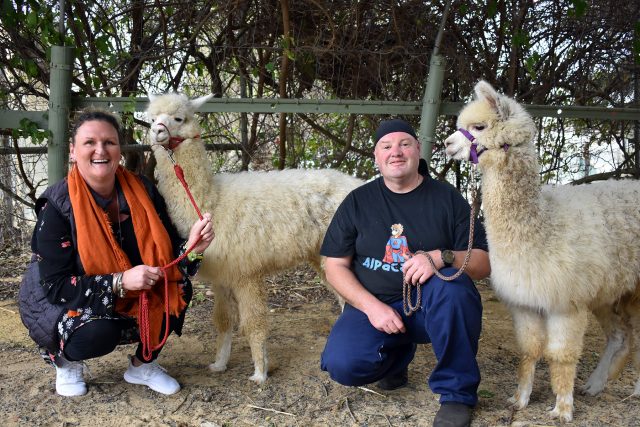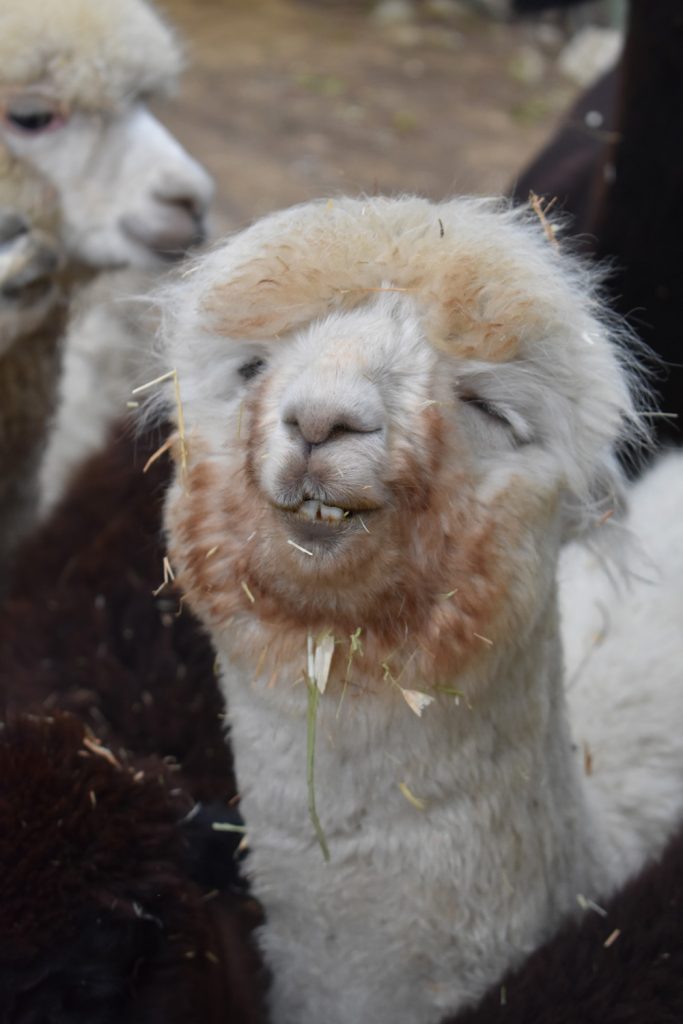Mamoes Alpaca Farmstay in Woodridge is self-contained cottage accommodation with the adorable bonus of roaming alpacas on site.
If you are unable to visit the farmstay but are wanting an alpaca fix, owners Paul Southam and Nikki Bland can still bring the alpacas to you with Mamoes Travelling Alpacas!
Mamoes Alpacas — whose name came courtesy of Nikki and Paul’s’ daughter Indi and her pronunciation of the word tomatoes as a toddler, “She called them ‘mamoes’,” says Paul — stemmed from a need to protect the family’s chickens from fox attacks.
“When I looked into it to see what would help stop the foxes, we found out alpacas do the job,” said Paul. “I actually had alpacas back in the 90’s, when they were very expensive — they are much more affordable now. We got our first one, Nutmeg about five years ago.”
An empty cottage on their property provided a business opportunity to create farmstay accommodation. Woodridge’s central location and the niche addition of alpacas has proved to be particularly popular with international guests.
“Overseas travellers drive a lot of kilometres on the road when they are here — from Kalbarri down to Busselton; I think where we are is quite a good central spot for them. You also have Moore River 15 minutes up the road, which is lovely,” says Nikki.
Word of the alpacas quickly spread and Paul and Nikki were faced with frequent, unannounced day trippers wanting to visit the alpacas. Not wanting to impinge on the experience of their farmstay guests, they decided to take the alpacas to the people instead.
And it seems there’s few activities that can’t be improved with the addition of a few alpacas. Birthday parties, baby showers, hens’ nights, weddings, visits to Bunnings and an appearance at radio station 92.9’s RnB Fridays Live concert have all featured on the alpaca’s calendar.
“I think it’s just something a bit different, maybe a bit quirky,” says Nikki. “It’s a good experience to see what an alpaca actually is — a lot of people ask ‘What’s the difference between a llama and an alpaca?’”
So, what is the difference? Paul explains, “The way to remember it is ‘Llama Banana’ – banana-shaped ears for a llama and ‘A for Alpaca’ – A-shaped ear for alpaca. Llamas are also probably about twice the size and twice the weight of an alpaca.”
According to the Department of Agriculture, the official date that alpacas were first introduced in Australia is 1989, but there is a curious tale in the history books that dates alpacas back much further. Optimistic English entrepreneur Charles Ledger struck a deal with the NSW Government and spent five years driving a flock of approximately 260 alpacas, llamas and vicunas (an ancestor of the domestic alpaca) out of Peru bound for Australia – completely illegally as the export of alpacas was banned in Peru! Travelling through Bolivia to Argentina, across the Andes to Chile, Charles and his team eventually arrived in Sydney on the ship Salvadora in November 1858.
Once in Sydney, Ledger faced many problems, including a dwindled commercial interest and failure by the NSW government to honour their original agreement. Although some reports suggest the flock thrived and managed to breed, many alpacas died during a drought in early 1860’s. The remaining were sparsely distributed around the country and there were none left by the end of the 19th century.
“Alpacas are now fully domesticated worldwide and Australia has the second highest number of domesticated alpacas after their native South America. They come in twenty-two different colours and live to about 25 years,” says Paul.
A form of animal therapy, Mamoes Alpacas are frequent visitors to aged care facilities, their friendly and approachable nature bringing joy to the residents.
“The expressions on the faces of the people are just lovely. A lot them can’t get out at all, so it’s nice to bring in some animals. They just give them a pat and it seems quite calming for them. We listen to a lot of stories, it’s very sweet and certainly a good feeling doing that,” says Nikki.
“Many of them have grown up on farms so miss interacting with animals,” Paul adds.
With international travel to Australia currently on hold, guests from Perth are starting to discover the magic of Mamoes.
“Everybody from Perth is wanting to come up, which has been great! We’re fully booked up until October. People are getting away and it’s great to see. Kids from the city love to just run around or climb the mulberry trees and feed the alpaca mulberry leaves, it’s one of their favourite foods,” says Nikki.
Emerging from the COVID-19 bubble that put so many events and travel-based businesses on hold, Nikki and Paul are pleased to see things picking again and to be sharing their love of alpacas with Western Australians.
“I’m happy to keep riding this wave and see where we go!” said Nikki.
Paul laughs, “We can always get some more alpacas!”
You can follow the adventures of Nikki, Paul and the alpaca herd on Facebook @mamoesalpacas.










